Safaris are a great way to have that thrilling experience with wildlife. The phenomenon of safari tourism has become popular across several destinations in India and countries in the world where people flock to natural destinations to observe wild animals in their habitat. When it comes to the best time of safari, then the question comes between night safaris or morning safaris. Both have their own benefits and challenges. In this article, we will go into detail about the difference between a night safari and a morning safari, and which option will give you a chance for better wildlife sightings.
Morning Safari: Adventures with Nature’s New Beginnings
The early morning hours are said to be special times for wildlife. With the first rays of sunlight shining through the morning, nature comes alive, and a great many wild animals stir about. At this time, deer, elephants, tigers, and a plethora of smaller animals are observed.
Benefits of Morning Safari:
Experience the landscape with nature: the coolness of morning air sentiments, golden rays of sunlight, and soundless nature beautifies a safari.
- The emergence of more wildlife: Most of the animals are active early in the morning for food or for water. Hence, the chances of encounters increase.
- Safe and easy: Safaris are safer in daylight and easier for visitors to move around.
Cons of Morning Safari:
- Have to wake up early: Safari time starts very early in the morning, which can be difficult for some people.
- Not all animals are visible: Some nocturnal i.e. animals active at night are less visible in the morning.
Night Safari: Secrets Hidden in the Dark
The night safari offers a host of different kinds of thrills and experiences. Numerous wild animals ranging from owls, bats, and even a few large predators are nocturnal. You will be able to see creatures that you might never see during the day on these night safaris.
Advantages of Night Safari:
- Nocturnal animal sighting: This safari gives you the unique opportunity to see nocturnal creatures.
- Calm and peaceful atmosphere: The silence of the night and the cool breeze make for a special safari experience.
- With just expert guides: Most night safaris have expert guides who give you information about animal activities and the environment.
Disadvantages of Night Safari:
- Low visibility: It can be difficult to spot animals in the dark, so this safari can be somewhat more challenging.
- Safety Concerns: Safety is necessary at night as animals can be more active and unpredictable.
- Fewer animals are visible: Some larger animals are hidden at night and are less visible.
Which safari should you choose?
Choosing a safari depends on your priorities, experience, and convenience. Morning Safari is better for you if you want to enjoy every color of nature and morning freshness. Meanwhile if you want to see especially nocturnal fauna or want a different experience then choose Night Safari.
Note: Many wildlife sanctuaries offer both options, and you can also do both safaris at your convenience.
Safari Experience and Preparation
It is pertinent to take note of some things concerning the proper preparation for a safari to the end that the experience turns out to be memorable and safe:
- Dress right: Mornings are cold, so carry warm clothes. Wear lightweight but full arm and leg clothes for the night safari to avoid bugs.
- Take the help of a guide: With the help of a guide, you will be able to see the animals better and understand their habits.
- Make sure camera and equipment are ready: Special equipment such as night vision or flash may be necessary for cameras especially at night in night safaris.
- Follow safety rules: Strictly follow the rules in the forest, ensuring your safety.
Conclusion
Both the morning safari and the night safari are amazing in their own way. The morning safari gives you the opportunity to see the freshness of nature and more animals, while the night safari introduces you to the creatures that are not seen during the day. A morning safari might be better to start with if you are going for the first time. Meanwhile, if you want experience and adventure, opt for Night Safari.
There’s a day or night wildlife safari that’s the most phenomenal life experience you will ever have. Be in touch with nature at its best, see animals in their native world, and realize how valuable forests are for the whole planet.
FAQs
Q1. What is the best shutter speed for wildlife photography?
A. For fast-moving subjects like birds in flight, use at least 1/2000 sec. For running animals, 1/1000 sec works well. Use 1/250–1/500 sec for still subjects.
Q2. Which aperture setting should I use in wildlife photography?
A. Use a wide aperture like f/2.8 to f/5.6 to blur the background and focus on the subject. For group shots or more depth, f/8–f/11 is suitable.
Q3. What ISO is ideal for wildlife photography in low light?
A. In good light, ISO 100–400 is perfect. For shady areas or dawn/dusk, increase it to ISO 800–1600. In very low light, ISO 3200+ may be required.
Q4. Should I use manual or auto focus in wildlife photography?
A. Use Continuous Autofocus (AF-C or AI Servo) to keep moving subjects sharp. Dynamic or Zone AF is better than single-point for action shots.
Q5. What is the advantage of using Burst Mode?
A. Burst Mode captures multiple frames per second, increasing your chances of getting the perfect shot during fast movement or sudden animal behavior.
